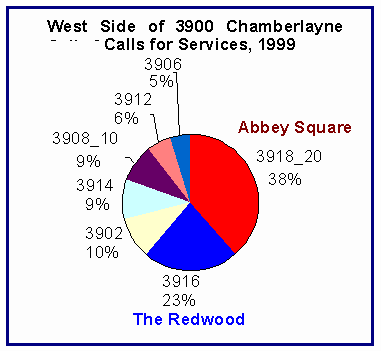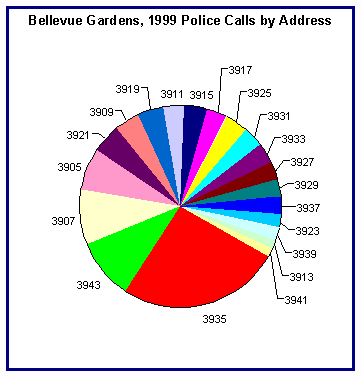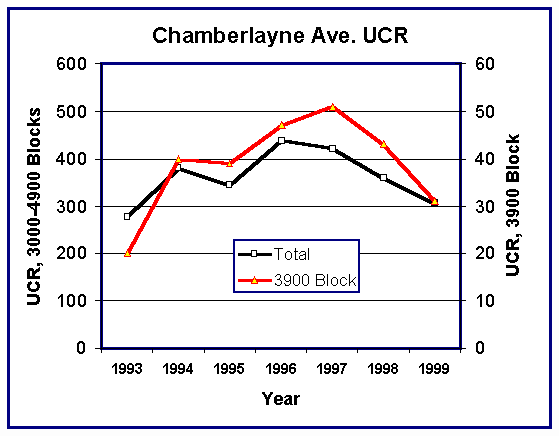Parent Pages
Sibling Pages
Child Pages
|
Chamb. Ave Study |
|
Parent Pages
Sibling Pages
Child Pages
|
Here is a potpourri of correspondence on the Chamberlayne Ave. study being done by Mort Gulak of VCU. The supporting data for some of the editorial content are on our web site.
From: <%20JohnRButcher@attbi.com%20>
To: <santoca@ci.richmond.va.us>,
Charlie,I still do not have an electronic copy of the earlier draft. I will insist
on receiving an electronic copy of the next one for posting on our web page
and otherwise for email sharing with my neighbors.----- Original Message -----
From: "Charles A. Santo" <santoca@ci.richmond.va.us>
To: <%20JohnRButcher@attbi.com%20>; <Mdldcl@aol.com>
Cc: "Sacks, David M. - DCD"
"Sherry, M Jamie - DCD-"
<mgulak@saturn.vcu.edu>
Sent: Wednesday, April 05, 2000 5:36 PM
Subject: Chamberlayne Avenue Steering Committee
>
> Chamberlayne Avenue Steering Committee Members:
>
> After reviewing the comments of the Steering Committee members (written
> comments and comments from our previous) it seems that meeting again on
> April 11, as previously discussed, would not be the most beneficial use of
> everyone's time. Instead, City staff and Dr. Gulak would like to collaborate
> to incorporate changes to the draft document prior to holding another
> committee meeting. In particular, we would like to restructure the document
> to be consistent with the discussion at the March 22nd meeting and address
> the written comments that have been received. Once the draft is revised,
> copies will be shared with the Steering Committee for review and another
> meeting will be scheduled. We will continue to collect written comments for
> the time being, but the sooner these comments are received, the sooner we
> will be able to begin work on some changes. At this time we foresee having a
> revised draft available in approximately two to three weeks.
>
> Thank you for you hard work and dedication to this process. As always, if
> you have any questions, feel free to contact me at 646.6361 or
> santoca@ci.richmond.va.us.
>
> I will be sending a memo by regular mail to all committee members, but would
> appreciate any help you can give in spreading the word. Thanks.
>
> Charlie Santo
> Planner
> City of Richmond
> Department of Community Development
> 804.646.6361
MEMORANDUM
BY FACSIMILE: 646-6358
TO: Charlie Santo, Planner
Department of Community Development
City of RichmondFROM: John Butcher
DATE: March 21, 2000
RE: Chamberlayne Avenue Corridor Strategy Plan
Draft of March 1, 2000
Thank you for the copy of this document that you delivered to my home on March 15, 2000 and for the missing pages 18 and 29 that you faxed to my office the following day. I write to provide my comments for the Steering Committee meeting on March 22.
Background
This draft is dated March 1. The City distributed it on March 15 with a notice that the Steering Committee will meet on March 22, apparently to discuss the draft. Thus the City has gestated the draft study at least since the public meeting of August 12, 1999 and has held the draft for fifteen days since it was complete but expects the Steering Committee to react within seven days.
Because of the unrealistically short time the draft has been available I have not been able to consult fully with the Bellevue Civic Association. Thus the comments below are my own, not those of the Association. I request that another meeting be scheduled in a few weeks so I will have sufficient time to share this report with my neighbors and provide their evaluation to the City.
Comments
This report fails to identify the two solutions to the fundamental problem in the Chamberlayne Avenue corridor. The City has zoned Chamberlayne Avenue to allow construction of apartment complexes (and, to a lesser extent, adult homes). These uses have converted the Chamberlayne corridor into the epicenter of crime in an otherwise peaceful neighborhood. The long-term solution to this situation is to correct the zoning and return the corridor to single-family residential uses. The short-term solution is to require the property owners to control or evict the tenants whose antisocial behavior is harming the entire neighborhood.
1. The Fundamental Problem Is Crime
In the Apartment Complexes·
The scope of services for this study lists four issues, with public safety first and physical appearance last. That is an appropriate, most-important-first list. At Page 1 the draft report lists four "elements" for discussion:o
Design charactero
People in the corridoro
Land use & developmento
Public safety
Thus we see that public safety has moved from first place in the scope of services to last place in the draft report. Indeed the draft report devotes 3.5 pages of recommendations ("vision") to design character, three pages to sense of community and a corridor association, three pages to land use and development, and one page to public safety. The draft report has thus inverted the hierarchy of needs.
·
At Page 17 the draft report says that "[n]uisance and other crimes have effected (sic) the image of the corridor." This characterization of the public safety disaster as an "image" problem is the report’s fundamental defect. The report concentrates on appearance instead of the criminal acts of apartment residents and their harm to the persons and the property of the residents of the corridor and the nearby neighborhoods.
The central problem in the corridor is criminal behavior by tenants in the apartments. This is not to say that all the renters in the corridor are criminals. To the contrary, there are isolated pockets of disorder from place to place. For example, of the seven apartment complexes on the west side of the 3900 block, two adjoining complexes were responsible for 61% of the calls for police services in 1999, and one of those by itself was responsible 38% of the calls:

·
Even within particular properties there are islands of disorder. For example, of the twenty units in the Bellevue Gardens Apartments on the east side of the 3900 block, four were responsible for over half the police calls in 1999 and one was the source of 26% of the calls:

These centers of turmoil are possible only where the apartment management fails to control the unruly tenants.
·
Aside from anecdotes, the draft report provides no data to support the statement on Page 12 that "a few" residents of adult homes have committed nuisance crimes. The high rate of calls for police services from some of the adult homes indicates more than "a few" problems there. Here is the list of addresses with the highest rate of calls in 1999, with the adult homes highlighted:
|
Address |
Total |
Owner |
|
3207_11_15 |
154 |
Court Assoc. |
|
3905 to 43 |
145 |
Bellevue Gardens |
|
3918_20 |
127 |
Abbey Square |
|
3505 |
115 |
Bernestein Assoc. |
|
3210_12 |
95 |
B&N Assoc. |
|
4301 to 27 |
81 |
Chamberlayne Gardens |
|
3916 |
75 |
Woelfl |
|
4801 to 19 |
71 |
Chamberlayne Gardens |
|
4930 |
60 |
J&R |
|
3401 |
58 |
DLM Corp |
|
3206 |
55 |
Page |
|
3006 |
47 |
Court Assoc. |
|
3603_5 |
39 |
Zacharias |
|
3406 |
36 |
Court Assoc. |
|
3813 |
35 |
Bellevue Gardens |
Of course, some of the calls for service from the adult homes reflect the medical and other problems to be expected there. Once the police department makes the crime reports available by address it will be possible to more accurately assess the impact of the adult homes.
·
At Page 14 the draft report admits that, externally at least, the apartment complexes in the corridor appear "well maintained and in good repair" and that "[t]he corridor’s sound building stock is as (sic) a major asset." In fact, to the casual eye Chamberlayne Avenue looks all right. In this context the focus of the draft report on aesthetics instead of the notorious crime problem is especially regrettable.·
At page 2 and elsewhere the draft report mentions the public meeting held on August 12, 1999. The report does not include the notice to that meeting. That notice announced the purpose of the meeting in the following terms:To examine existing conditions, review possible directions for change and solicit your vision for the future.
The notice did not mention the public safety problem in the Chamberlayne corridor. In contrast, at Page 2 the draft report says that the majority of the responses to the survey distributed at the meeting identified public safety as the most important need for the near future.
2. The Property Owners Can and Must
Abate the Crime from the Tenants
·
The draft report fails to inform the reader that the City’s efforts to deal with disorder in the Chamberlayne Avenue corridor have been fragmented and ineffective. Indeed, the City has demonstrated that its usual processes are impotent to solve the tenant problem. The formidable efforts of the Ginter Park Association have produced only modest improvements.At Page 2 the draft report says that the property owners surveyed "indicated that they would consider working together to address [crime and other] problems." Thus, despite the scandalous crime rate on Chamberlayne Avenue, the property owners implicitly admit that they have made no systematic effort to solve the problem
This is particularly unfortunate because the property owners have the power to abate the disorder emanating from their property. If they refuse to tolerate antisocial behavior by their tenants they can eradicate most of the crime on Chamberlayne Avenue.
·
At page 26 the draft report says that the predominance of one bedroom apartments gives rise to problems such that the apartment managers "cannot control crime and other unwanted behaviors of lesser sorts." As discussed above, that statement is false. Granted, if there were no apartments most of the crime problem would not exist. That is why rezoning is crucial. But the apartments do exist and while they do the landlords are in the best position to control the crime there. Only the landlords can evict the individuals whose antisocial behavior is injuring the other tenants, the property values of the landlords themselves, and the entire neighborhood. Indeed, at Page 28 the draft report contradicts its own error in this respect and recognizes that "[t]he role of apartment managers is key for improving conditions."·
It should go without saying that no property owner may allow his property to reach a condition where it is dangerous to the public. Moreover, the owner cannot avoid responsibility for the harm simply because it is caused by his tenants. If a property owner will not control his tenants’ antisocial behavior the society can and should require him to do so.3. The Underlying Cause of the
Crime Problem is the Zoning
·
The zoning change in 1942 vandalized a peaceful, residential neighborhood with a ribbon of disorder along Chamberlayne Avenue. As the draft report recognizes at Page 25, the recent improvements in the zoning ordinance, most recently in 1996, at best "reduce the opportunity for the development of new, large apartment buildings and large (over 8-person) adult care residences." Simple equity requires that the opportunity for further destructive development be extinguished and that the neighborhood be returned to its former, peaceful condition.·
At Page 25 the draft report says it "does not recommend changes to current land uses on Chamberlayne Avenue." The report proposes cosmetic measures such as improvements to the streetscape but disdains repair of the zoning blunder that created the disaster on Chamberlayne Avenue.Now that the consequences of the City’s zoning error are manifest, it is unacceptable that the draft report not propose that the City modify the zoning and other institutional constraints to absolutely prevent further deterioration and to abate the damage the City already has done.
4. Miscellaneous Remarks
·
At Page 9 the draft report says that the "boulevard design is deteriorating" and that the corridor "is losing its role as an important place and as a scenic gateway into the City." In fact, the deterioration is more concluded than in progress. The corridor has about one highway robbery per month and more than five reports of promiscuous shooting per month. Prostitutes and drug dealers openly market their products in the parking lots and on the streets. The Avenue no longer is a gateway; it is a crime scene.·
The footnote on Page 14 says that there are more addresses than buildings, and then reports a larger number of buildings than addresses.·
At Page 16 the draft report says that the residents and neighbors "are alarmed about increasing criminal activity." That statement is accurate but imprecise. The crime in the corridor has decreased for the last two or three years; before that it increased sharply, in contrast to the City, state, and national rates that have been decreasing regularly since 1991. For the period of record (the Chamberlayne data only go back to 1993) the crime in the corridor is slightly up. See the figure below.
The report should contrast this increase in the Chamberlayne corridor with the general decrease since 1991 in Richmond, in Virginia, and across the nation.
·
At Page 17 the draft report says "the majority of crime in the area . . . was property-related rather person-related (sic)." That is the case citywide and, indeed, nationally. For instance, the 1998 UCR data show that 16% of the Richmond crime was violent, i.e., 84% was property crime.·
At Page 17 the draft report says "personal and property offenses are prevalent." Earlier on the same page the draft report classifies crime into "person-related" and "property-related" (in contrast to the FBI, which classifies crime as "violent" and "property"). Of course, if all crime is either personal or property, it is not surprising that personal and property offenses are prevalent in this area where crime is conspicuously prevalent.·
At Page 19 the draft report proposes formation of a corridor association as the highest priority for change. At the same time the draft report recognizes the transient nature of many of the tenants and the general indifference that transients show to neighborhood institutions. It also reports upon the (very effective) neighborhood organization (the Ginter Park Association) already in place here. Thus the draft report sets a first priority to create an organization whose success is problematic and in a place where an effective organization already exists. It would make more sense to create a task force in the Ginter Park organization. Moreover, the suggestion that the first priority is to form an association, rather than to reduce criminal behavior completely misses the point.·
At Page 21 the draft report suggests that renovations should "adhere to the original design of the structure." Surely that is not the solution for the shoebox apartment complexes that present blank, brick walls to the street.·
At Page 26 the draft report says that City action such as code enforcement can help the corridor. The City already has demonstrated at the Redwood and elsewhere that this approach, standing alone, will not work. As the report recognizes, most of the buildings in the corridor are adequately maintained.·
At Page 47 the Appendix says that the list of offenses "does not include drug or prostitution arrests." This appendix, however, appears to be based on a list of offenses reported to the police, not arrests.Conclusion
The fundamental problem on Chamberlayne Avenue is the criminal disorder spawned in the apartment buildings and adult care residences. There are two solutions: Short term, require the landowners to maintain order on their own properties; long term, correct the City’s zoning blunder. This draft report disdains both of these remedies and devotes its energies to cosmetic proposals that, while interesting and important, cannot cure the serious crime problem in the Chamberlayne corridor. The report must be redrafted to cure these elementary defects.
\\THINKPAD\C\My Documents\Santo Memorandum Re C Ave Study
Draft 000322.Doc
Printed March 21, 2000 at 10:29 PM
Last updated 02/24/02
Please send questions or comments to John
Butcher